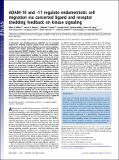| dc.contributor.author | Miller, Miles Aaron | |
| dc.contributor.author | Meyer, Aaron Samuel | |
| dc.contributor.author | Beste, Michael T. | |
| dc.contributor.author | Lasisi, Zainab A. | |
| dc.contributor.author | Reddy, Sonika N. | |
| dc.contributor.author | Jeng, Karen | |
| dc.contributor.author | Griffith, Linda G. | |
| dc.contributor.author | Lauffenburger, Douglas A. | |
| dc.contributor.author | Chen, Chia-Hung | |
| dc.contributor.author | Han, Jongyoon | |
| dc.contributor.author | Isaacson, Keith B. | |
| dc.date.accessioned | 2013-12-30T18:34:02Z | |
| dc.date.available | 2013-12-30T18:34:02Z | |
| dc.date.issued | 2013-05 | |
| dc.date.submitted | 2012-12 | |
| dc.identifier.issn | 0027-8424 | |
| dc.identifier.issn | 1091-6490 | |
| dc.identifier.uri | http://hdl.handle.net/1721.1/83378 | |
| dc.description.abstract | A Disintegrin and Metalloproteinases (ADAMs) are the principal enzymes for shedding receptor tyrosine kinase (RTK) ectodomains and ligands from the cell surface. Multiple layers of activity regulation, feedback, and catalytic promiscuity impede our understanding of context-dependent ADAM “sheddase” function and our ability to predictably target that function in disease. This study uses combined measurement and computational modeling to examine how various growth factor environments influence sheddase activity and cell migration in the invasive disease of endometriosis. We find that ADAM-10 and -17 dynamically integrate numerous signaling pathways to direct cell motility. Data-driven modeling reveals that induced cell migration is a quantitative function of positive feedback through EGF ligand release and negative feedback through RTK shedding. Although sheddase inhibition prevents autocrine ligand shedding and resultant EGF receptor transactivation, it also leads to an accumulation of phosphorylated receptors (HER2, HER4, and MET) on the cell surface, which subsequently enhances Jnk/p38 signaling. Jnk/p38 inhibition reduces cell migration by blocking sheddase activity while additionally preventing the compensatory signaling from accumulated RTKs. In contrast, Mek inhibition reduces ADAM-10 and -17 activities but fails to inhibit compensatory signaling from accumulated RTKs, which actually enhances cell motility in some contexts. Thus, here we present a sheddase-based mechanism of rapidly acquired resistance to Mek inhibition through reduced RTK shedding that can be overcome with rationally directed combination inhibitor treatment. We investigate the clinical relevance of these findings using targeted proteomics of peritoneal fluid from endometriosis patients and find growth-factor–driven ADAM-10 activity and MET shedding are jointly dysregulated with disease. | en_US |
| dc.description.sponsorship | National Institutes of Health (U.S.) (Grant R01-EB10246) | en_US |
| dc.description.sponsorship | National Institutes of Health (U.S.) (Grant U54-CA112967) | en_US |
| dc.description.sponsorship | David H. Koch Institute for Integrative Cancer Research at MIT (Frontier Research Program Initiator Award) | en_US |
| dc.description.sponsorship | Repligen Corporation (Fellowship in Cancer Research) | en_US |
| dc.language.iso | en_US | |
| dc.publisher | National Academy of Sciences (U.S.) | en_US |
| dc.relation.isversionof | http://dx.doi.org/10.1073/pnas.1222387110 | en_US |
| dc.rights | Article is made available in accordance with the publisher's policy and may be subject to US copyright law. Please refer to the publisher's site for terms of use. | en_US |
| dc.source | PNAS | en_US |
| dc.title | ADAM-10 and -17 regulate endometriotic cell migration via concerted ligand and receptor shedding feedback on kinase signaling | en_US |
| dc.type | Article | en_US |
| dc.identifier.citation | Miller, M. A., A. S. Meyer, M. T. Beste, Z. Lasisi, S. Reddy, K. W. Jeng, C.-H. Chen, et al. “ADAM-10 and -17 regulate endometriotic cell migration via concerted ligand and receptor shedding feedback on kinase signaling.” Proceedings of the National Academy of Sciences 110, no. 22 (May 28, 2013): E2074-E2083. | en_US |
| dc.contributor.department | Massachusetts Institute of Technology. Center for Gynepathology Research | en_US |
| dc.contributor.department | Massachusetts Institute of Technology. Department of Biological Engineering | en_US |
| dc.contributor.department | Massachusetts Institute of Technology. Department of Biology | en_US |
| dc.contributor.department | Massachusetts Institute of Technology. Department of Chemical Engineering | en_US |
| dc.contributor.mitauthor | Miller, Miles Aaron | en_US |
| dc.contributor.mitauthor | Meyer, Aaron Samuel | en_US |
| dc.contributor.mitauthor | Beste, Michael T. | en_US |
| dc.contributor.mitauthor | Lasisi, Zainab A. | en_US |
| dc.contributor.mitauthor | Reddy, Sonika N. | en_US |
| dc.contributor.mitauthor | Jeng, Karen | en_US |
| dc.contributor.mitauthor | Griffith, Linda G. | en_US |
| dc.contributor.mitauthor | Lauffenburger, Douglas A. | en_US |
| dc.relation.journal | Proceedings of the National Academy of Sciences | en_US |
| dc.eprint.version | Final published version | en_US |
| dc.type.uri | http://purl.org/eprint/type/JournalArticle | en_US |
| eprint.status | http://purl.org/eprint/status/PeerReviewed | en_US |
| dspace.orderedauthors | Miller, M. A.; Meyer, A. S.; Beste, M. T.; Lasisi, Z.; Reddy, S.; Jeng, K. W.; Chen, C.-H.; Han, J.; Isaacson, K.; Griffith, L. G.; Lauffenburger, D. A. | en_US |
| dc.identifier.orcid | https://orcid.org/0000-0002-1801-5548 | |
| dspace.mitauthor.error | true | |
| mit.license | PUBLISHER_POLICY | en_US |
| mit.metadata.status | Complete | |
